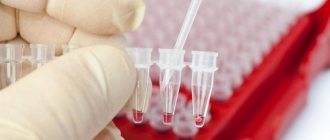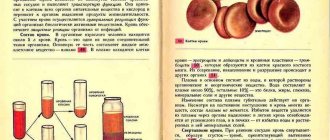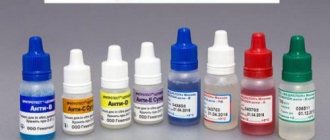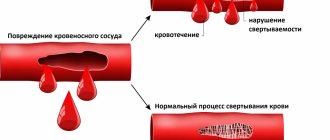The activated partial thromboplastin time (aPTT) test characterizes the state of one of the three mechanisms of the hemostatic system - coagulation (blood clotting). Using the APTT analysis, all types of hemophilia are diagnosed - A, B and C, as well as hereditary, autoimmune diseases and the phases of DIC syndrome are determined.
You can take the APTT test and get reliable results with a transcript of the analysis in the Laboratory of Hemostasis Pathologies at the MLC, the base clinic of Moscow State Medical University named after. Sechenov.
When is an APTT test prescribed?
APTT is part of the blood tests for hemostasis, which are taken when planning pregnancy. The test is also prescribed for genetic predisposition to thrombosis, spontaneous bleeding of unknown origin, diagnosis of hemophilia, treatment of heart attack, during pre- and postoperative examinations.
Based on the results of the analysis, the presence of coagulation inhibitors is determined - signs of systemic lupus erythematosus and antiphospholipid syndrome, severe autoimmune pathologies. The APTT test is also used to monitor heparin therapy.
Complexes with this research
Female infertility Analysis of the state of female reproductive health RUR 9,790 Composition
Extended coagulogram Extended study of the functional state of hemostasis RUR 2,730 Composition
Examination during pregnancy. 1st trimester 10,390 RUR Composition
IN OTHER COMPLEXES
- Pregnancy planning. Clinical indicators 3,880 R
- Coagulogram RUR 1,110
- Miscarriage RUB 29,050
- Entry into IVF RUB 15,030
- Examination during pregnancy. 3rd trimester 5,730 RUR
Benefits of analysis
APTT is a highly focused study that diagnoses several pathologies of hemostasis. The coagulation mechanism of hemostasis ensures the “sealing” of damage in blood vessels with fibrin clots and is influenced by blood coagulation factors.
Using the APTT test, you can detect a deficiency of the main factors affecting coagulation:
- 2nd, prothrombin;
- 5th, proaccelerin;
- 8th, antihemophilic globulin;
- 9th factor;
- 10th, Fr. Stewart-Prower;
- 11th, Dr. Rosenthal;
- 12th, Dr. Hagemann.
How is aPTT blood test performed?
Clotting is a vital process that is responsible for reducing the body's loss of blood. If coagulation is normal, then all elements interact normally in the process of thrombus formation. The order of activation of coagulation factors, which is called the coagulation cascade, has several pathways - general, external, internal. It is the latter that triggers intravascular thrombus formation.
Blood is taken from a vein. The collection is carried out in a vacuum tube containing sodium citrate, which stops clotting. The material can then be stored for about 6 hours. The collected material is centrifuged and separated into plasma and platelets. Next, reagents with an activator and phospholipids with cephalin are introduced into the plasma. After the required time, CaCl is introduced.
CaCl is a coagulant, and cephalin triggers the tissue thromboplastin pathway. The time during which the liquid fraction is converted into a fibrin clot is immediately recorded. In this way, the initiation of coagulation along the internal pathway is simulated and the probable deficiency of the factors that participate in it is revealed.
It should be noted that there are quite a few of them involved in this process, and determining which one we are talking about is a matter of subsequent examination. The resulting time is the result of the APTT.
When the result is needed cito - that is, urgently, it can be obtained in 30-40 minutes. With a standard examination, the result is usually obtained the next day. If the study is carried out in conjunction with others, there may be a delay in obtaining results of up to 7 days, depending on the degree of readiness of other tests.
Decoding
The standard for the test is 24-35 seconds. Physiological changes in hemostasis occur in the body of expectant mothers, so the APTT during pregnancy is reduced to 17-20 seconds. The type of pathology is determined based on the shortening or lengthening of the APTT.
What does it mean if APTT is higher than normal?
Prolongation of APTT is a sign of deficiency of blood coagulation factors: 8th in hemophilia A, 9th in hemophilia B, 11th in hemophilia C, as well as von Willebrand disease - an inherited tendency to spontaneous bleeding.
If the marker increases, additional tests are performed for lupus anticoagulant and antiphospholipid syndrome, and if the patient receives heparin injections, the dose of the drug is adjusted.
What does it mean if APTT is below normal?
A shortening of the activated partial thromboplastin time indicates the risk of developing thrombosis - blockage of blood vessels, or thromboembolism - a blood clot breaking off and entering the circulating blood. Low aPTT determines the first phase of disseminated intravascular coagulation.
If venous blood is collected incorrectly or the sample is contaminated, a decrease in the marker is also observed - in such cases, the analysis is repeated.
Pregnancy and APTT level
A pregnant woman is prescribed a coagulogram every three months. This test must be taken so that the doctor has maximum information about the state of her health. After all, at this time, a restructuring of the hormonal background occurs, another circle of blood circulation is formed, which delivers nutrition to the child. This circle is called the uteroplacental circle. In addition, the body is preparing for the fact that in the near future it will have to lose a certain part of the blood. Therefore, changes affect the entire hemostatic system.
Any pathology of the blood coagulation system during pregnancy is doubly dangerous than in normal times. This almost always carries a risk of serious complications. Therefore, doctors carefully monitor APTT and other blood parameters. In the blood of a pregnant woman, the level of fibrinogen increases, which can reach a value of 6.0 g/l, and the aPTT can be shortened compared to such indicators for a non-pregnant woman.
The range of normal APTT values in pregnant women ranges from 14-20 seconds. More accurate values are determined in the specific laboratory where the research is carried out.
If the APTT time is shortened, the likelihood of blood clots increases. In pregnant women, these risks increase several times. Blood clots can form anywhere, but if they form in the vessels of the placenta, this can lead to premature detachment.
An increase in APTT causes excessive blood thinning, which increases the likelihood of uterine bleeding. This condition is dangerous not only for the pregnant woman herself, but also for her unborn child.
Also, with changes in APTT values, there is a risk of developing such a dangerous complication as disseminated intravascular coagulation syndrome. First, blood clots form in a woman’s blood, and then the blood stops clotting. This threatens massive blood loss, which is very difficult to stop.
DIC syndrome is poorly corrected with drug therapy. This condition is a pressing problem in modern obstetrics and gynecology, as it can cause death.
Even if a woman is absolutely healthy, but is pregnant, she is prescribed a blood coagulogram every 3 months. This allows you to control the hemostasis system, and therefore monitor the health of the woman and the fetus. If there are any diseases or risks, the analysis is performed as often as necessary to provide adequate treatment. Indications for unscheduled blood donations for analysis are previous miscarriages, the fact of stillbirth, the presence of gestosis, and increased uterine tone.
Where to get tested for APTT in Moscow
You can take an APTT test and get advice from an experienced hemostasiologist at the Women's Medical Center on Zemlyanoy Val. Our Hemostasis Pathology Laboratory has high-precision blood analyzers, high-quality reagents and consumables, which guarantees the reliability of the research results.
Along with the APTT test, you have the opportunity to take tests close to it: 2-TEG, extended hemostasiogram, tests for VA and APS, Antithrombin, and also determine the anti-Xa activity of heparin in the blood. In the experimental laboratory of the MLC, we are engaged not only in diagnostics: we research and practice new methods for treating hematological diseases.
In one of the private laboratories you are another statistical unit, but with us you are a patient who is ready to be helped by the best doctors in Moscow.
How to prepare for the APTT study?
Blood donation is preceded by some preparation. On the eve of blood donation, alcohol consumption and sports training are excluded. It is also necessary, if possible, to reduce the influence of psycho-emotional factors. After 20-22 pm on the evening before the test, you cannot eat anything, but you can drink water.
If the test is taken urgently, during the day, then you need to wait at least 4 hours after your last meal. Before donating blood, especially if the laboratory is on the top floor and the person climbed the stairs, it is recommended to rest for about 15 minutes.
Article on the topic:
Norms of total protein in the blood of women. Table and transcript of analyzes
If the patient is taking heparin drugs, the half-life of which lasts about 3 hours, then it is necessary to take a test either 3 hours after the administration of heparin or an hour before. Children under 5 years of age must be given up to 200 ml of boiled water for half an hour before the test.
Preparation for delivery
The results may be unreliable due to the influence of factors such as taking certain medications, exposure to thromboplastin due to significant injury to the vein, and much more. To prevent such situations, the patient is recommended to follow simple preparatory measures:
- 7-14 days before donating blood, stop taking medications (if possible, after agreement with your doctor);
- 7 days before taking biological material, avoid alcoholic beverages and coffee;
- 1 day before taking biomaterial, limit sports activities;
- In the morning before the examination, refrain from smoking;
- 30 minutes before the procedure, you can drink a glass of clean water without gas.
It is important to note that thrombin time testing is not indicated for women during the menstrual period, since hormonal changes occurring at this time may change the reliable data.
APTT is one of the most important laboratory indicators, the determination of which makes it possible to completely diagnose even small deviations from the norm. This test makes it possible to identify most bleeding disorders (especially hemophilia, which has been diagnosed in a large number of people in recent years) and begin therapy in the early stages, preventing the development of severe and even life-threatening consequences. At the MedArt clinic you can take an APTT test and get reliable data in the shortest possible time. The information received must be passed on to the attending physician, who will be able, based on the information received, to make an accurate diagnosis and draw up a plan for further treatment.
How to lower APTT
To reduce aPTT it is recommended:
- coagulant therapy - Tranexam, Dicynon;
Tranexam
Dicynone - vitamin therapy with vitamin K - Vikasol injections;
Vikasol - treatment of underlying diseases;
- blood transfusion with an increased coagulation index.
A diet high in animal proteins will be beneficial. It is recommended to eat more lard, butter, fatty cottage cheese and sour cream, fatty cheeses and fish, eggs, red meat, red vegetables and fruits, legumes, and herbs.
When is the study scheduled?
APTT is an important component of diagnosis. It is actively used to confirm a large number of diseases and prevent the development of life-threatening situations:
- Hemophilia and other bleeding disorders (eg, von Willebrand disease);
- Monitoring the condition of the patient who is undergoing treatment with heparin and hirudin;
- Identification of the cause of myocardial infarction and search for optimal treatment tactics;
- Suspicion of acute leukemia (may be an additional diagnostic criterion);
- Search for the cause of bleeding of unknown etiology (including after childbirth or surgery);
- Monitoring hemostasis in pregnant women, identifying the causes of miscarriages and infertility;
- Preparation for surgery (non-compliance of thrombin time with the norm is a contraindication to the start of surgery).
DIC syndrome , deserves special attention . This pathology represents the activation of coagulation mechanisms, which results in increased thrombin formation. This leads to the formation of microthrombi in microvessels - the hypercoagulation phase. After this, with a high degree of probability, a transition phase develops, which is characterized by impaired microcirculation. Active formation of fibrin leads to activation of fibrinolysis, which begins to surpass coagulation. This is the hypocoagulation phase, during which the risk of bleeding increases greatly. It occurs due to depletion of coagulation factors during the period of hypercoagulation. By eliminating the etiology of DIC (taking certain medications, poisoning, and much more), it is possible to normalize the body’s condition and prevent undesirable consequences. In the absence of timely intervention, a decompensation phase occurs, which is characterized by blockage of blood vessels. As a result of this, blood does not flow to the organ, tissue necrosis occurs and bleeding resumes due to complete incoagulability of the blood.
Method of determination
This procedure is quite common, so patients do not have any difficulties or problems with it. The main biological material for determining thrombin time is blood. The resulting biomaterial sample is placed in a special laboratory tube with sodium citrate. This chemical compound has the ability to bind calcium ions, which prevent clotting. Then the tube with the resulting blood is sent to a centrifuge, after which plasma with a minimum number of platelets is obtained. To activate the intrinsic coagulation pathway, an activator (for example, kaolin) and phospholipids are added to the plasma sample. After this, a solution of calcium chloride is added to the biological material, which helps to utilize the anticoagulant effect obtained by citrate). The final stage of this procedure is to measure the time until a blood clot forms. It is this indicator that is fundamental for assessing health status. Regardless of whether the APTT is increased, decreased or within normal limits, the laboratory worker always displays the results obtained on the appropriate form. If the name of the test contains the word “partial,” this indicates the absence of tissue factor in the reagents used.
Reasons for the decline
When the level drops, the blood becomes thick. It is highly likely that the body produces a lot of specific proteins.
Why is this happening:
- DIC syndrome at the first stage. A condition in which liquid connective tissue begins to randomly coagulate directly in the vessels. The pathology is hereditary or secondary, caused by hormonal disorders. There are exceptions.
Hypercoagulation, and therefore low aPTT, is typical only at the very beginning of the disease. Then the disorder turns 180 degrees, everything becomes the other way around.
- Thrombosis.
- Thromboembolism. In both cases, the drop in the indicator is the result of a secondary pathological process. And sometimes there is no connection at all.
There are also natural factors. Although some of them can be called that very conditionally.
- Exercise stress. Why this happens has already been said earlier. Intense release of hormones, loss of water. The amount of functional blood volume decreases, and cortisol and other steroids accelerate the synthesis of coagulation factors. The result is hypercoagulation. But this is a temporary phenomenon. A healthy body solves the problem itself and quickly brings the system back to normal.
- Errors in nutrition. Substances such as caffeine and tannin have a negative effect on the condition of the blood and blood vessels. They are found in popular drinks. However, as in the previous case, this is not dangerous. At least for healthy people.
- Stressful situations. They provoke an active release of cortisol and adrenaline. It is impossible to completely get rid of nervous tension, because the body. Sometimes symptoms persist for years. It all depends on adaptive abilities.
- Smoking. Patients with considerable experience are especially at risk. The body adapts to the negative factor, but it only seems so. In fact, a person simply stops noticing problems.
- Alcohol is no less aggressive. Ethanol causes hypercoagulation and thickens the blood. The process is complex. When the patient drinks regularly, the disorder becomes persistent. Doesn't go away on its own.
If the aPTT is low, this means that the blood is too thick and this situation is ideal ground for thrombosis. Without treatment, everything can end in disaster.
If APTT is below normal
If aPTT is reduced, the doctor may suspect:
- I phase of DIC syndrome;
- presence of cancer;
- amyloidosis;
- vascular diseases;
- liver diseases.
However, often a decrease in the indicator can be caused by more mundane reasons:
- abuse of fatty foods;
- taking certain medications - thromboplastin, etc.;
- dehydration.
A low level warns of the possibility of developing thrombosis and thromboembolism. To clarify, additional research is carried out on fibrinogen and other elements.
Article on the topic:
LDH in a biochemical blood test - what is it?
In case of any deviations and in the absence of complaints, it makes sense to retake the analysis again. Some inconsistencies can cause sampling errors: for example, if blood is squeezed out or if the drawing is done through a catheter.
APTT is increased. What does it mean?
If the aPTT is elevated (that is, more time is spent clotting than necessary), hypocoagulation can be suspected. This condition occurs either as a result of a decrease in the amount of pro-coagulants, or with increased activity of anti-coagulants. This may be the first sign of:
- leukemia;
- hemophilia;
- liver diseases;
- DIC syndrome;
- lack of vitamin K.
The result may be high if a person is treated with heparin or warfarin. Antibiotics, aspirin, asparaginase, thrombolytic medications, quinine, cholestyramine, enoxaparin, and cyclophosphamide also have an effect on the prolongation of APTT.
The study is much more informative if it is prescribed simultaneously with the determination of prothrombin time. A high indicator always warns of an increased risk of bleeding for the slightest reason.
Need for diagnostics
Often, determination of aPTT is prescribed for the diagnosis of the following pathologies and conditions associated with the treatment:
- Hemophilia. With this dangerous disease, spontaneous or trauma-mediated hemorrhages occur in internal organs and muscles.
- Thrombosis or genetic predisposition to it. Clots form in the blood vessels, preventing free blood flow.
- Excessive bleeding and bruising that occurs without an obvious traumatic stimulus.
- Disseminated intravascular coagulation syndrome (DIC), which is based on excessive stimulation of blood coagulation processes.
- Treatment of cardiovascular diseases.
- Monitoring heparin therapy aimed at reducing clotting.
- Determination of deficiency of certain coagulation factors underlying diseases characterized by bleeding.
- Planning the operation to prevent large blood loss.
- Postoperative condition.
- Pregnancy, infertility, cases of premature spontaneous birth.
- Diseases associated with low or high levels of fibrinogen protein, which, under the influence of enzymes, is converted into the basis of a blood clot. Excess fibrin leads to blood clots in blood vessels, while too little fibrin leads to bleeding.
- Liver diseases. This organ is involved in the production of fibrin.
- In chronic glomerulonephritis, blood filtration is impaired, and the formation of blood clots disrupts this process.
The essence of the analysis and what the research shows
APTT (also APTT) is an auxiliary method of an extended coagulogram. They always study it. From the patient's point of view, there are no differences from a standard blood test. After the laboratory technician has collected the biomaterial, it is sent to a specialist.
How to work with a sample:
- The blood is divided into fractions. Doctors are interested in the liquid part, that is, plasma. She is low on platelets, which is exactly what she needs. Otherwise, the formed cells will disrupt the overall picture and affect the results. The main component remains in place: these are special proteins, fibrinogen and coagulation factors.
- Next, special chemical reagents are added to the clean sample. Calcium chloride, koalin and cephalin. This is a kind of provocative test that shows how efficient the clotting factors are. Ultimately, the sample should coagulate.
- APTT is calculated in seconds. Accordingly, when the blood completely changes compared to the initial state, then we can talk about the end of the analysis. The period from the introduction of reagents to the coagulation of liquid tissue is called APTT.
- Deciphering does not present any great difficulties if the reference values and counting methods are known. An increase in APTT means hypocoagulation: the time increases, the blood clots more slowly. It's liquid. A decrease in the indicator is hypercoagulation. The fabric reacts too quickly. It's thick. In the future, this condition almost guarantees thrombosis.
This study is rarely carried out in isolation. It's informative, but there are a few problems:
- As such, the indicator does not diagnose external coagulation disorders. That is, nothing is known about the work of platelets, their adhesion and aggregation. This is where the problem may lie.
- On the other hand, there are major differences in the methods that laboratories use. Therefore, there is no single normal meaning. This imposes certain requirements on the work of the doctor and the laboratory itself.
Specialists must indicate the ways in which they examine biomaterial. It doesn’t hurt for a hematologist to familiarize himself with the technology. Requires in-depth knowledge in diagnostics.
Basically, APTT is carried out in parallel with the study of prothrombin time.
How to increase APTT
To increase APTT, the following techniques are used:
Anticoagulant therapy:
- heparin medications, Pradaxa, Clexane;
Pradaxa
Clexane - taking medications of the fibrinogen group - Warfarin;
Warfarin - taking antiplatelet agents - medications based on acetylsalicylic acid to thin the blood - Aspecard and Aspirin.
Aspecard
Aspirin
A therapeutic anti-cholesterol diet is also recommended for the patient. Cholesterol plaques impede blood flow, and its slowdown, in turn, leads to increased coagulation and a decrease in aPTT. Vitamin-mineral complexes containing vitamins E, C, A and omega3 will also be useful.
COVID-19 is associated with increased blood clotting. Patients with COVID-19 often have elevated levels of D-dimer, high concentrations of which are a predictor of death. Experts from the International Society of Thrombosis and Hemostasis (ISTH) believe that an increase in D-dimer levels by 3-4 times in a patient with COVID-19 is an independent indication for hospitalization.
Patients with COVID-19 are often diagnosed with both obvious thrombotic complications with the identification of large blood clots (not only in the veins and pulmonary arteries, but also in the heart, brain vessels, kidneys, liver), and signs of thrombosis at the microcirculatory level, which is intravital quite difficult to prove. Some researchers suggest that in COVID-19, thrombosis of the microvasculature may underlie damage to many organs, including multiple organ failure. For example, thrombosis of the renal vessels can lead to increasing renal failure, and of the microvasculature of the lungs - to worsening respiratory failure. Interestingly, when the myocardium is damaged by signs of inflammation and interstitial fibrosis, viral particles are not detected directly in the myocardium. Researchers suggest that myocardial damage may develop against a background of hypoxia, microvascular thrombosis, and a systemic inflammatory response.
The mechanism of hypercoagulation in patients with COVID-19 is presumably associated with severe endothelial dysfunction and induction of platelet aggregation (the endothelium carries ACE2 receptors and is a target for the SARS-COV-2 virus). Separate series of studies have also been published in which an increase in titers of antibodies to phospholipids was detected in patients with COVID-19 and massive thrombosis (https://www.nejm.org/doi/full/10.1056/NEJMc2007575), however, such transient changes may be nonspecific nature, since they are often detected during a pronounced inflammatory reaction.
Now the prescription of anticoagulants in a prophylactic dose in hospitalized patients with severe COVID-19 to prevent venous thromboembolism has become almost universal practice; This therapy has been shown to reduce mortality in patients with COVID-19. Clear indications for prescribing anticoagulants have not been determined, and the question of which drugs are best to use has not been fully resolved. Theoretically, it appears that unfractionated heparin, which has its own anti-inflammatory effects, may have some benefits. Moreover, it is believed that it may reduce the binding of viral particles to target cells. On the other hand, the use of UFH requires more frequent nurse visits to the patient (several times a day), which exposes staff to greater risk. Therefore, many clinics in the United States use direct oral anticoagulants to prevent VTE.
However, to date, expert communities recommend the use of low molecular weight heparins in severe patients with COVID-19. Thus, ISTH recommends prescribing LMWH in a prophylactic dose to all patients hospitalized due to COVID-19, even if they are not in intensive care (contraindications - active bleeding, thrombocytopenia <25 -="" 1500="" 8="" p= "">The latest version of the temporary recommendations of the Ministry of Health of the Russian Federation for the treatment of patients with COVID-19 says the following in this regard: "It is recommended to include low molecular weight heparin drugs in the treatment regimens of such patients. The criterion for prescribing drugs may be cumulative changes in the general blood count (thrombocytopenia) and coagulogram (increased D-dimer level, prothrombin time) or the risk of developing coagulopathy, which was stratified according to the sepsis-induced coagulopathy (SIC) scale" (https://static-1.rosminzdrav.ru/system/attachments/attaches/000/ 049/951/original/09042020_%D0%9C%D0%A0_COVID-19_v5.pdf).
In severe patients with COVID-19, the frequency of thrombotic complications remains high even with the use of anticoagulants in a prophylactic dose, so some experts are discussing the possibility of prescribing anticoagulants in a full, therapeutic dose.
Given the lack of an adequate evidence base, the management of anticoagulant therapy in each severe patient with COVID-19 should be discussed individually, taking into account the risk of thrombosis and bleeding.
Experts recommend monitoring indicators that characterize blood coagulation, such as prothrombin time, D-dimer, fibrinogen levels, and platelet count.
Patients with severe COVID-19 often develop thrombocytopenia, but hemorrhagic complications are rare. Laboratory signs of hypocoagulation without bleeding do not require any correction.
If patients develop major bleeding, empirically fresh frozen plasma (FFP) should be used, Ermassa should be used if indicated, then the tactics depend on laboratory parameters:
- if INR>1.5 or increase in aPTT by more than 1.5 times - use FFP
- if fibrinogen is less than 1.5 g/l - cryoprecipitate or fibrinogen concentrate
- if platelets are less than 50 thousand / μl - platelet transfusion
- in the absence of signs of disseminated intravascular coagulation, tranexamic acid can also be used; - recombinant factor VIIa preparations should not be used.
Based on materials:
- ACC/Chinese Cardiovascular Association COVID-19 Webinar 1. https://www.youtube.com/
- Thachil J et al. ISTH interim guidance on recognition and management of coagulopathy in COVID-19. published: 25 March 25, 2020 (link)
- Hunt B et al. Practical guidance for the prevention of thrombosis and management of coagulopathy and disseminated intravascular coagulation of patients infected with COVID-19. March 25, 2021. Published on
Text: Shakhmatova O.O.









